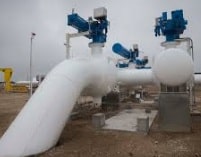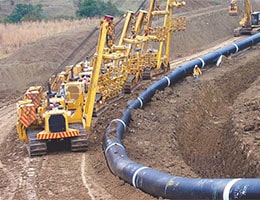 A gas pipeline is a very extensive and thick pipe that allows a fuel gas to be transported over a long distance. It is common for the gas pipeline to start in a natural field and then head to a distribution center.
A gas pipeline is a very extensive and thick pipe that allows a fuel gas to be transported over a long distance. It is common for the gas pipeline to start in a natural field and then head to a distribution center.
Also called a gas pipeline , a gas pipeline allows gas to circulate at high pressure . Gas pipelines are generally pipes that are buried at a depth of between 1 and 2 meters. In some cases, however, these pipes develop above the surface .
In this context, the pressure unit known as bar is used, which is equivalent to one million baria , the unit defined as the pressure exerted by a force of one dyne over a space of one square centimeter. The unit of force called dyne is equivalent to 10 newtons raised to the power of minus 5, or to the force that when applied to a mass of one gram gives it an acceleration of one centimeter per second squared.
In the basic network, gas usually circulates through the gas pipeline with a pressure of 72 bar . To reach homes, in the urban distribution network the pressure is reduced to 16 bar .
Although the regulations governing their creation and operation may vary from country to country, gas pipelines must meet various criteria for safety reasons. The installation of valves that allow the flow to be interrupted at certain intervals in the event of an accident (such as a leak that negatively affects the gas pressure) and sensors that can detect possible leaks and the creation of compression stations are some of the measures. usual.
These compressor stations must be placed along the gas pipeline, at a specific distance from each other, in cases where the pipeline is very long. This security measure is usually complemented by the installation of fiber optic cables that allow information on the status of the gas pipeline to be transmitted so that operators can detect leaks in time. The construction of roads to facilitate access to points where leaks occur, as well as the installation of firefighting equipment and emergency stations are also regulatory.
To minimize the environmental impact of gas pipelines, the construction process undergoes various inspections. Then, the footprint produced by the installation of the gas pipeline on the land is also analyzed.
 Typically, the pipeline begins near a seaport through which ships carrying liquefied natural gas ( LNG ) pass, natural gas that has gone through the process necessary to transport it in a liquid state. Their starting point can be a regasification plant or a field, although sometimes they are installed to connect gas plants with others that are dedicated to packaging and are located in the city.
Typically, the pipeline begins near a seaport through which ships carrying liquefied natural gas ( LNG ) pass, natural gas that has gone through the process necessary to transport it in a liquid state. Their starting point can be a regasification plant or a field, although sometimes they are installed to connect gas plants with others that are dedicated to packaging and are located in the city.
Other purposes that lead to the construction of a gas pipeline are distribution along a specific network of pipes (which can be found in a city, a factory or a consumption center) and the filling of cylinders.
There are two fundamental techniques to lay a gas pipeline across a river: horizontal and directional drilling . They serve to avoid any disturbance to the fauna and flora of the place. They can also be applied to cross railway lines, highways and roads.
The longest gas pipeline in the world is located in China . With an extension of more than 8,000 kilometers , it was inaugurated at the end of 2012 and required an investment of about 22,570 million dollars . This line allows the transportation of nearly 30 billion cubic meters of gas annually .
